Speaker
Description
The paper will present and discuss challenges in interdisciplinary student collaboration where the students have different skills and experiences in design and visualization. The paper is based on the reflections on ten years of teaching “Projects in urban development: Architecture, form and space” course. Approximately 60 students participate every year and belong to three different master’s study programs: landscape architecture, real estate development and urban and regional planning. The course focuses on urban development at project level and within the context of a specific Norwegian municipality. The students are organized into interdisciplinary groups, and their design skills vary. This exposes the students to practice-relevant situations where they can explore opportunities and test quality goals related to physical density, structural relationships and effects on the city's form and content. The assignment is a feasibility study in the first stage of a planning task, where the visual material is used in analyses, idea development and presentation stages. The data employed in this study involves a combination of students’ work, course assessments, and teachers’ reflection on didactical challenges. The aim of the paper is to demonstrate the power of design as an instrument for interdisciplinarity and complex problem-solving. We argue that design is a powerful tool to prepare students for dealing with socio-spatial challenges and that visual literacy plays an important role in understanding the spatial dimension and foreseeing the future.
| Keywords | design; design thinking; visual literacy; collaborative learning; planning education |
|---|

